Establishment of crops under grasslands
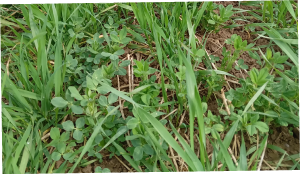
Mélanie Petit has implemented a cropping system under grassland to increase soil fertility, find synergies between the cover and the crop, and address the issue of ryegrass in her fields.
By "grassland," we mean "permanent AND perennial cover", which is significantly different from permanent cover with crops lasting only a few months from a soil perspective. The notion of permanence is essential for good exploration of the entire soil profile and the management of perennial grasses.
Farm Context
- Name: Mélanie Petit.
- Location: Bagneaux, Yonne (89). Champagne Sénonaise, industrial crop plains.
- Farm name: Ferme Vivante 89.10.
- Productions: Cereals (wheat, white oats, small and large spelt), buckwheat, lentils, seed-bearing sainfoin.
- Livestock: 50 Black Head Manech sheep.
- Utilized agricultural area: 325 ha, with 67% containing perennial legumes with a cover of 50 to 100%.
- Number of people working on the farm: 2 (Mélanie and her husband Jean-François).
- Soil: Chalky subsoil at varying depths. The main pedological trend consists of slightly leached brown soils “clay-limestone” sometimes with flint, with more calcareous areas of the calcosol type, and 2 plots with deep alluvial soils along the Vanne river.
- Label: Organic Farming.
- Commitment: Member of the GIEE supported by Eaux de Paris.
- Marketing methods: Primarily long circuit, developing short circuit (flours, lentils, lambs):
- Cereals: Processing into flours: Bags and direct sales to creperies for buckwheat flour.
- Lentils and small spelt: Bags.
- Lambs: Boxes.
The direct sales mainly go through a "farm drive-through" (online order with collection points), but constitute a small part of the production which mostly goes through the long circuit (cooperative).
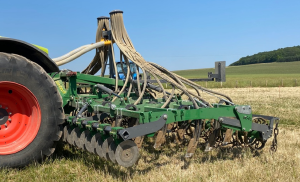
Farm history
- 2008: Acquisition of a 150 ha farm, expansion in 2011 and then in 2017. Initially, the agronomy followed soil conservation agriculture practices with annual covers.
- 2015: Transition to organic standards and the first crops under permanent cover in 2018.
- 2018: Testing of no-till seeding under cover of white clover with the first techniques of no-till seeding under permanent cover that included a pre-seeding scalping.
- 2022: No-till seeding into larger covers like alfalfa with the acquisition of a T-SEM pasture over-seeder from SIMTECH, an inverted T-slot seeder with disc openers (mounted by a company in Aube department). Concurrently, the farm is transitioning from white clover pastures to alfalfa, and this year (2023) testing multi-species pastures of alfalfa-clover-sainfoin-birdsfoot trefoil.
Farm News: A technical day with a field tour was organized on the farm, hosted by Agrof’Ile and funded by Eaux de Paris. It attracted 30 participants, indicating strong interest in the agronomy of this grassland-based agriculture.
Motivation and objectives
With the arrival of their children, the farming couple no longer wanted to consume what was produced on the farm, which led them to convert to Organic Farming in 2015. Already practicing soil conservation agriculture, they initiated no-till seeding under permanent cover in 2018, mainly to manage the high pressure of ryegrass.
The objectives are:
- Increase soil fertility.
- Find synergies between perennial plants and annual crops.
- Management of perennial grass "weeds".
Implementation steps
- In 2018, they began winter cereal seeding under white clover cover, with white clover being planted under sunflower cover. Aware of the root competition between clover and cereals, they are currently testing alfalfa pastures as well as diversified pastures of alfalfa-clover-sainfoin-birdsfoot trefoil.
- Much of this was done intuitively, and the technical itinerary is not fully established. The seeding is done broadcast or with a precision seeder, usually followed by rolling. Spring plantings under cereal cover did not work well. Post-harvest success depends on the year's moisture, and summer buckwheat cover seems to work better (to be confirmed).
- Seeding is generally done at half-rate, not necessarily all at once for the mixes but with the addition of one or the other depending on what needs to be supplemented. At 1/4 rate, surface soil work is needed to limit perennial grass germination (like false seeding), but the result is dirtier crops than at full rate. At full rate (tested this year 2023), the result is zero ryegrass, but the weight of the alfalfa caused lodging during a storm. So, half-rate seems to be an acceptable compromise, but needs to be seen long-term if it stays clean or not. Dwarf white clover at full rate also poses problems, as it significantly dries out the topsoil. Hence the evolution towards mixed pastures to try to combine the advantages of each while limiting competition. But caution, these are just observations/intuition and have little factual basis. Overall:
- White clover alone at full rate: 10kg/ha.
- Alfalfa alone at half-rate: 12kg/ha.
- Mix of white clover-alfalfa-sainfoin-birdsfoot trefoil: 3-6-20-5 kg/ha (~1/4 rate for each). The germination variability according to the soil is significant with much more sainfoin in some areas and alfalfa in others. To be seen over time...
- Generally, seeding is done as early as possible (early October) after a frost. Last year (2022), the first frosts came much later. So, seeding took place after mowing for the tallest pastures, directly into green for the white clover.
- The first contracts for seed-bearing sainfoin allowed them to gain experience in managing temporary pastures.
- Main operations are performed by the farmers.
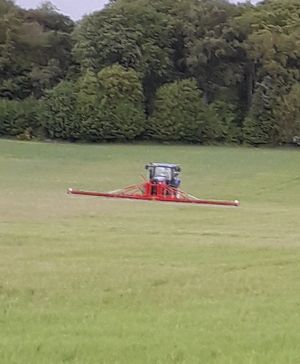
Challenges faced
- Establishing homogeneous pastures is a significant problem that is not yet fully resolved, but it seems to be improving with years and the over-seeding of legumes.
- Choosing an appropriate seeder for seeding under pasture in their context.
- Harvesting is sometimes complicated with a lot of green vegetation; a solution might be mowing and windrowing to facilitate threshing and sorting of cereals by drying the green before threshing, but also to limit grain drying and reduce energy consumption related to threshing. Another significant advantage of mowing and windrowing would be to facilitate the harvesting of sainfoin and alfalfa seed contracts. The main disadvantage would be the weather risk, which is still limited in summer compared to a hay cut in spring.
- With full-density pastures, the topper often clogs.
- In unscalped pastures, rodents pose some problems.
Opportunities encountered
- Collaboration with a former researcher to implement research processes on the farm to better understand the impact of the implemented practices on the soil.
- Completion of a carbon certification with Regeneration, which will provide them with a budget to work on soil improvement.
- Enhancing product value through processing and direct sales.
Assessment
The first trials were encouraging as the leguminous pasture visibly limited ryegrass. However, establishing homogeneous pastures took them several years.
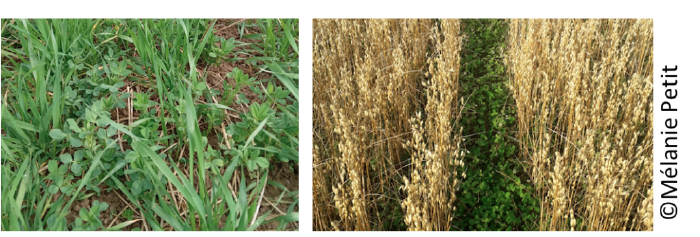
The agronomic system is not yet stabilized, and they do different things each year. With little information on these systems, it is difficult to know what they could do better or faster.
The farm's extensive practices attract curiosity from farmers and locals.
It is important to understand :
- How to successfully establish homogeneous pastures.
- Which pasture/crop associations would be most suitable for a given context.
- How to manage the harvest and stabilize what is harvested.
Advantages and points of caution
Advantages
- Management of perennial grasses.
- Limitation of erosion.
- Limited soil temperature during summer heat.
- Limited soil compaction due to fewer tractor passes.
- Very low crop costs, which limits economic risk.
- Promoted biodiversity; the plots, though quite large, are well populated with beneficials and game.
- It's visually more attractive!
Points of caution
- Choosing specific equipment suitable for practices and soils, with few references.
- Constant improvisation for seeding, crop management, and harvesting.
- Considering pedoclimatic and socio-economic contexts, getting inspired but not copying experiences from other farms.
Investments
- The extensive approach mobilizes 1 labor unit for crop management over 325 ha without subcontracting, the second labor unit works on product valorization.
- Crop costs are very low: around 80 euros/ha for fuel, and ~0 euros/ha for other inputs (zero pesticides, zero fertilizers, farm seeds), which greatly limits risks, but equipment investments must be chosen carefully as their amortization takes up a significant part of the farm's finances: the T-SEM seeder at 6m costs around 45,000 euros, the quotes (from 2022) for the mower-windrower are around 70,000 euros.
- The current mill used for making flour is on loan, but it does not produce flour quality acceptable for bakeries.
- The main risk is the lack of technical references and adequate advice. There is also no easy link with research to support the desire to use R&D approaches to capitalize on the experiences carried out on the farm.
Mélanie and Jean-François have received aid from the Common Agricultural Policy, subsidies for investments, AFAF and regional funding for planting hedgerows and agroforestry.
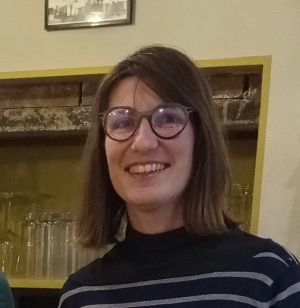
Advice
- Test on the farm on a small area. If alfalfa fields are present on the farm, it can easily be tested by extending alfalfa for a year to attempt no-till winter cereal seeding.
- Gain experience with perennial plants, either with seed contracts or by seeking advice from regional livestock farmers.
Prospects
- Diversify pastures.
- Develop livestock.
- Adapt buildings to the chosen agronomy: suitable buildings, sorting and storage equipment, cereal processing.
Sources
Interview with Mélanie Petit conducted by Romaric Vincent, agroforestry advisor, on the 12th of June 2023.